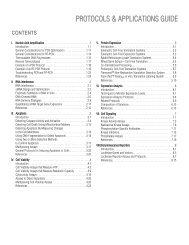2012 Promega catalogue
2012 Promega catalogue
2012 Promega catalogue
You also want an ePaper? Increase the reach of your titles
YUMPU automatically turns print PDFs into web optimized ePapers that Google loves.
Life<br />
Science<br />
Catalog<br />
<strong>2012</strong><br />
Worldwide Contact List<br />
Section<br />
Contents<br />
Table of<br />
Contents<br />
Cell Signaling<br />
Cell Signaling Antibodies<br />
Product Size Cat.# Price ($)<br />
Anti-pS 473 Akt pAb 40 µl G7441 500.00<br />
Immunocytochemical staining of Akt in embryonic rat brain cells.<br />
Embryonic (day 17) rat brain cells were collected and treated with<br />
20ng/ml each of EGF and FGF. Anti-pS 473 Akt pAb was used at a 1:50<br />
dilution. Positive cells were visualized using a donkey anti-rabbit, Cy ® 3conjugated<br />
secondary antibody. Nuclei were stained using DAPI. Protocols<br />
developed and performed at <strong>Promega</strong>.<br />
66<br />
A. 1 2<br />
B.<br />
1 2<br />
2769TA10_9A<br />
– Phospho-Akt – Akt<br />
Detection of phosphorylated Akt by Western blot analysis with AntipS<br />
473 Akt pAb. Panel A. NIH/3T3 total cell extract (10μg per lane) was<br />
resolved by polyacrylamide gel electrophoresis and blotted onto nitrocellulose.<br />
Lane 1, untreated cells; lane 2, cells pretreated with PDGF (Invitrogen) at<br />
50ng/ml for 20 minutes. Anti-pS 473 Akt pAb (Cat.# G7441) was used at a<br />
1:2,500 dilution. The blot was probed with Donkey Anti-Rabbit IgG (H + L),<br />
HRP, Anti-ACTIVE ® Qualified pAb (Cat.# V7951) at 1:10,000 dilution followed<br />
by chemiluminescent detection. Panel B. A pan-Akt pAb (New England<br />
Biolabs) reveals total Akt in both stimulated and unstimulated NIH/3T3 cell<br />
extracts. Secondary antibody and detection methods were the same as those<br />
used in Panel A.<br />
2810TA10_9A<br />
Product Size Cat.# Price ($)<br />
Anti-ACTIVE ® CaM KII pAb, Rabbit, (pT286 ) 40 µl V1111 671.00<br />
kDa<br />
250 –<br />
98 –<br />
64 –<br />
50 –<br />
36 –<br />
30 –<br />
16 –<br />
6 –<br />
4 –<br />
0.5µg 2.5µg 5µg 12.5µg 25µg<br />
+ – + – + – + – + –<br />
1 2 3 4 5 6 7 8 9 10 11<br />
– Phospho<br />
T 286<br />
CaM KII<br />
Detection of CaM KII by Anti-ACTIVE ® CaM KII pAb in Western<br />
analysis of rat brain homogenate. Lanes 2, 4, 6, 8 and 10 contain<br />
autophosphorylated (+) brain cytosolic protein in the amounts shown;<br />
lanes 3, 5, 7, 9 and 11 contain nonphosphorylated (–) brain cytosolic<br />
protein in the amounts shown. The presence of the autophosphorylated<br />
CaM KII was detected using the Anti-ACTIVE ® CaM KII pAb diluted 1:5,000.<br />
Panel A Panel B<br />
Panel C<br />
Immunocytochemical detection of autophosphorylated CaM KII in<br />
PC12 cells with Anti-ACTIVE ® CaM KII pAb. PC12 cells were adhered<br />
to slides coated with collagen, fixed in 10% paraformaldehyde for 30<br />
minutes, rinsed in PBS and permeabilized in methanol for 10 minutes<br />
at –20˚C. The cells were then blocked in 1% BSA in PBS for 45 minutes<br />
followed by 2% horse serum in PBS for 60 minutes. Cells were incubated<br />
overnight at 4˚C with (Panel A) Ab alone, (Panel B) Ab preincubated with<br />
a nonphosphorylated CaM KII peptide fragment (1μg/ml) or (Panel C) Ab<br />
preincubated with a phosphorylated CaM KII peptide fragment (1μg/ml). The<br />
Anti-ACTIVE ® CaM KII pAb was used at 1:500 dilution and preincubated<br />
with peptide for 8 hours at 4˚C. After incubation with the Anti-ACTIVE ® CaM<br />
KII pAb or Ab/peptide mixture, the cells were rinsed in PBS and incubated<br />
with a donkey anti-rabbit FITC-conjugated secondary Ab (1:500) for 60<br />
minutes at room temperature.The results demonstrate that preincubation<br />
of the Anti-ACTIVE ® CaM KII pAb with phosphorylated CaM KII peptide<br />
completely abolishes immunostaining (Panel C), but preincubation with<br />
nonphosphorylated CaM KII peptide has no effect on immunostaining (Panel A<br />
versus Panel B). Protocols developed and performed at <strong>Promega</strong>.<br />
For complete and up-to-date product information visit: www.promega.com/catalog<br />
2055TA02_8A<br />
2057TA02_8A
















